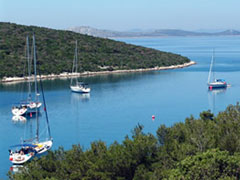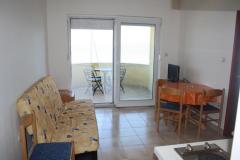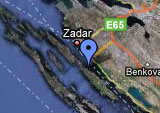About Island Pašman
 Island Pašman belonges to a group of Zadar islands, with Island Ugljan is connected by a bridge passing through Ždrelac and also with a ferry line from Zadar and Biograd. Current in this part changes every 6 hours, and makes the sea here among the clearest of the Adriatic. Ecologically preserved nature with many species of medicinal and aromatic herbs, vineyards, fields and olive groves with numerous sandy and pebbly beaches are the best choice for those who like to vacation away from busy life.
Island Pašman belonges to a group of Zadar islands, with Island Ugljan is connected by a bridge passing through Ždrelac and also with a ferry line from Zadar and Biograd. Current in this part changes every 6 hours, and makes the sea here among the clearest of the Adriatic. Ecologically preserved nature with many species of medicinal and aromatic herbs, vineyards, fields and olive groves with numerous sandy and pebbly beaches are the best choice for those who like to vacation away from busy life.
However, the Island Pašman is still insufficiently explored area, "terra incognita" of our history, but it is certainly an area that deserves research carefully, because it hides secrets waiting to be discovered.
Relief of the Island Pašman is marked with basic forms of limestone, indented coast and the influence of external factors. The highest peak is 272 meters (Big Bokalj). Central and southwestern part of the island is mostly rocky, unlike the north-eastern part of Island Pašman. Southwestern part of the predominantly limestone while the northeast part of has dolomite structure, marked by gentle areas with drifts of red soil and sand, which is enables greater exploitation of soil, and engage in agricultural activities. One of the characteristics of karst relief are speleology objects. On this island there are about 30 caves so far 6th of them are explored. In the words of local people the most fascinating is Big cavern on Komornjak, which has several chambers and a small lake. Testing of caves and holes should be done but everything points to their existence.
Climate is characterized by all the basic characteristics of Mediterranean climate with very dry summers and mild winters. The average annual temperature is above 15 ° C, the average temperature of the warmest month, July 24 ° C and the coldest January 12 ° C. Number of days with temperatures lower than 0 ° C is negligible, as the high is around 16 days a year. Average temperature of the coldest month of January is not lower than -3 ° C. No continuous high or continuous low temperatures, as there are no long periods of drought or rain. Insolation is about 2 500 hours per year, and in July the sun is shining 10 to 12 hours a day. The impact of climate on the sea is multifaceted, but it is mostly evident reduction of temperature variance. Sea is colder in summer than land, partly because the sun rays penetrated deeper into the sea. Therefore, the air above the sea surface is colder than on land, from where it originates and refreshing influence of the sea on close coastal area. From late August to mid-April, the sea is warmer than air, so at that time actes as a source of heat, cold winter emollient. Current in this part changes every 6 hours, and make this sea among the clearest of the Adriatic.
Pašman area is not exposed to strong winds. Bura blows mostly in winter, Jugo prevails in spring and autumn, and in summer from the west blowes pleasant landward breeze, very good for sailing and surfing. Summer and early autumn prevailing stable and good weather with sunny, first clear and warm days. After the morning calm, mid-morning starts with the sea wind, Maestral, in the afternoon reaches moderate strength. Direction is mainly north-west, and the steadfastness and strength quite make it very suitable for sailing, as nowhere else in the Adriatic. Bringing fresh sea air he really lowers the temperature at the time of the greatest daily heat. Maestral often lasts until late in the afternoon. Evening silence reigned, and the night wind, blowing poor from the land, is Burin. This type of weather is in about 80% of summer days, but sometimes is present in other seasons, from March to November. Weather then, of course, is not so warm as in summer, is somewhat cloudy, and coastal wind circulation is weaker than in summer. Bura is generally dry and cold wind that sometimes can be a storm strength. During summer is rare, fleeting and noticed less than in other parts of the year. Vedra or "clear" bura blows mainly in winter. Cloudy or "Škura" bura blows after Jugo and generally is stronger than the one that blows with cheerfulness. South or east-southeast wind mostly blows widely in the colder half, especially spring and autumn, and sometimes it blows a few days, developing high waves at sea, and is therefore dangerous to navigation. Cyclonic south bringes rain, sometimes with thunder. After Jugo, with the rapid passage of cold fronts in the south-east comes Tramontana, northwester accompanied with thunderstorms. Levant is chilly and rainy east wind that blows in the winter months, and sometimes bringes snow.

